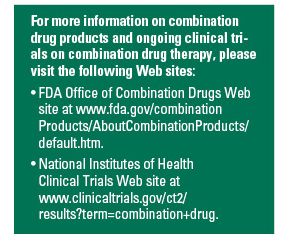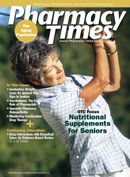Publication
Article
Pharmacy Times
Monitoring Combination Drug Therapy
Author(s):
Combination therapy is a frequently prescribed treatment for various medical conditions; however, problems can arise without thorough monitoring. Pharmacists can be instrumental in ensuring that combination drug therapy is used appropriately.
Ms. Terrie is a clinical pharmacy writer based in Haymarket, Virginia.
Combination drug therapy is defined as the use of 2 or more pharmacologic agents administered separately or in a fixed-dose combination of 2 or more active ingredients in a single-dosage formulation. Combination therapy is frequently prescribed by physicians to treat and manage a plethora of medical conditions; however, without thorough monitoring, various problems can arise. In some cases, patients must try several different combinations of drugs before finding the best therapy to successfully treat a medical condition. Pharmacists can be instrumental in ensuring that combination drug therapy is used appropriately by screening for potential drug—drug interactions, contraindications, or both, and by making therapeutic recommendations aimed at achieving optimal response without increasing the potential for adverse drug reactions. Pharmacists also can identify possible cases of polypharmacy, especially among elderly patients and those with multiple medical conditions. Combination drug therapies can offer additive benefits that target multiple pathologic processes.1
Pros and Cons of Combination Therapy
Pros: Combination drug therapy can be used initially or added gradually if the therapeutic response with monotherapy is not as expected. In addition to using 2 or more single agents as a treatment for a medical condition, various fixeddose combination formulations may offer several advantages, such as the convenience of fewer pills a patient is required to take daily and reduced potential for medication errors. Research has shown that simpler drug regimens may increase the likelihood of patient adherence, and, depending upon the pharmacologic agent, medication costs may also decrease.2-4 Combined agents also may minimize the adverse effects of each individual agent.4
Cons: Some concerns about using fixed-dose combination drugs include the lack of flexibility in altering the dosing of individual components and the exposure of patients to unnecessary therapy.3,5
The FDA’s policy on fixed-dose drug combinations states that 2 or more drugs may be combined in a single-dose form when each component makes a contribution to the claimed effects, and the dosage of each component is such that the combination is safe and effective for a significant patient population requiring concurrent therapy as defined in the labeling for the drug.3
Usefulness in Various Medical Conditions
Combination drug therapy is considered the standard of care in the treatment of several medical conditions. In conjunction with lifestyle modifications, combination drug therapy is often considered to be the best tool in the prevention and delay of the morbidity and mortality associated with cardiovascular disease (CVD) and its risk factors, especially for high-risk patients.3 Various studies have demonstrated that this approach also may be beneficial in the treatment and management of chronic medical conditions, such as diabetes mellitus, Alzheimer’s disease, rheumatoid arthritis, malignancies, pain disorders, neurologic disorders, pulmonary disorders, as well as HIV and other infectious diseases.1,3 Chemotherapeutic agents in various combinations comprise regimens for treating specific cancers.
Hypertension
According to The Seventh Report of the Joint National Committee (JNC 7) on Prevention, Detection, Evaluation, and Treatment of High Blood Pressure, results from recent trials demonstrate that effective blood pressure control can be achieved in some patients with hypertension. To meet the target goal of <130/80 mm Hg, however, the combina- 48 n 01.10 | Pharmacy Times www.PharmacyTimes.com Rx focus Monitoring Combination Drug Therapy Yvette C. Terrie, BSPharm, RPh tion of 2 or more drugs is often necessary. 6 Several antihypertensive combination regimens are now available, including beta-blocking agents with diuretics, angiotensin-converting enzyme inhibitors (ACEIs) with diuretics, angiotensin II receptor blockers (ARBs) with diuretics, or calcium channel blockers (CCBs) with ACEIs or ARBs.7
Results from studies have demonstrated that the use of pharmacologic agents such as thiazide diuretics, beta-blockers, ACEIs, ARBs, and CCBs have been beneficial in decreasing the incidence of CVD and stroke in hypertensive individuals with diabetes.6 In addition, the combination of an ACEI and a thiazide diuretic has been shown to decrease the rate of recurrent strokes among some individuals.6 Because hypertension is a multifactorial condition, studies show that the combination of 2 antihypertensive agents with different mechanisms of action, such as a dihydropyridine CCB plus an ACEI or ARB, may provide additional benefits, and many studies have demonstrated that combination therapy increases the capacity to lower blood pressure compared with monotherapy.7
Results from clinical trials report that only 30% of hypertensive patients achieved and maintained adequate blood pressure control with monotherapy. 2 Many patients with hypertension tend to require more than a single agent, especially if they have comorbid conditions. 5 Some studies suggest that combination therapy for initial management offers the potential to achieve blood pressure goals sooner and with fewer adverse effects, because lower doses of each agent may be used.5 Results from a study by Jameson et al evaluated the efficacy and safety of initial combination therapy versus that of monotherapy in patients with stage 2 hypertension who, according to the JNC 7 recommendations, met the criteria for the use of initial antihypertensive combination drug therapy. The results concluded that combination therapy was well-tolerated and resulted in greater reductions in blood pressure.8
Diabetes
Combination drug therapy is often used to treat diabetes. Some of the advantages of using combination drug therapy in diabetes include the following:
• Better glycemic control with 2 drugs that work at different sites
• Fewer side effects with lower doses of 2 drugs than a large dose of 1 drug
• When combined in the same pill or capsule, the likelihood of patient adherence to therapy may increase and the cost may be lower, depending on the agent.9
Patients with type 2 diabetes may also require other medications to treat or prevent disease-associated complications. Aspirin and statins are often used for cardioprotection, and ACEIs/ARBs are used for renal protection.10
Effectiveness in Other Conditions
Additional studies point to the effectiveness of combination therapy for Alzheimer’s diease, arthritis, and breast cancer. The results from a clinical trial published in the Journal of the American Medical Association demonstrated that individuals with Alzheimer’s disease treated with a combination of the N-methyl-D-aspartic acid receptor antagonist, memantine hydrochloride, and the cholinesterase inhibitor, donepezil, showed a slower rate of decline in cognitive function and behavioral changes, compared with those who took only donepezil.11 A study published in the May 2009 issue of Arthritis and Rheumatism reported that using a combination of disease-modifying antirheumatic drugs compared with using just 1 agent to treat early rheumatoid arthritis results in higher long-term remission rates.12 In breast cancer, docetaxel, doxorubicin, and cyclophosphamide are often used together in one chemotherapy regimen. Results from a study published in 2009 state that combination therapy with exemestane and celecoxib has shown promising results in treating advanced breast cancer.13
Fixed-Dose Combinations
Some drugs used in combination may potentiate the effects of the other, such as the combination of amoxicillin (a penicillin derivative) and clavulanate (a beta-lactamase inhibitor). Clavulanate increases the effectiveness of amoxicillin against resistant strains that carry the beta-lactamase gene.14,15 The standard treatment for HIV is known as highly active antiretroviral therapy, and these agents are often available in fixeddose combination formulations. Some of these fixed-dose combinations are from the same class, such as the nucleoside analogues, and include abacavir and lamivudine.14,16 Other fixed-dose combinations, such as the HMG-CoA reductase inhibitor, atorvastatin, and the CCB, amlodipine, are used to treat hyperlipidemia and hypertension— 2 major risk factors for heart disease.14,17
Conclusion
Combination drug therapy is often necessary for the management and treatment of various chronic medical conditions, including CVD, hypertension, and diabetes. As more fixed-dose combination formulations become available, they should be considered for use with the aims of improving patient adherence, simplifying drug regimens, and optimizing care. Patients should be encouraged to maintain routine visits with their primary health care provider so they can be properly monitored. Although studies have shown that combination drug therapy is often beneficial for the treatment of many patients, pharmacists are vital to ensuring that these agents are used appropriately by screening for potential drug—drug interactions, contraindications such as hepatic or renal problems, and unnecessary drug use. â–



References
1. Xiong G, Doraiswamy PM. Combination drug therapy for Alzheimer's disease: what is evidence-based, and what is not. Geriatrics. 2005 Jun; 60(6):22-6.
2. Taylor AA. Combination drug treatment of hypertension: have we come full circle? Curr Cardiol Rep. 2004 Nov; 6(6):421-6.
3. Orloff DG. Fixed combination drugs for cardiovascular disease risk reduction: regulatory approach. Am J Cardiol. 2005 Nov 7; 96(9A):28K-33K.
4. Frank J. Managing hypertension using combination therapy. Am Fam Physician. 2008 May 1; 77(9):1279-86.
5. Sica DA. Fixed-dose combination therapy--is it time for this approach to hypertension and dyslipidemia management? J Clin Hypertens. 2004 Apr; 6(4):164-7.
6. Escobar C, Barrios V. Calcium channel blocker based combination therapy: the best approach in the treatment of high risk hypertension. Medscape Web site. www.medscape.com/viewarticle/581412. Accessed November 4, 2009.
7. JNC 7 Express: The Seventh Report of the Joint National Committee on Prevention, Detection, Evaluation, and Treatment of High Blood Pressure. U.S. Department of Health and Human Services, National Institutes of Health, National Heart, Lung, and Blood Institute, National High Blood Pressure Education Program. NIH Publication No. 03-5233. December 2003. www.nhlbi.nih.gov/guidelines/hypertension/express.pdf. Accessed November 3, 2009.
8. Jamerson KA, Nwose O, Jean-Louis L, Schofield L, Purkayastha D, Baron M. Initial angiotensin-converting enzyme inhibitor/calcium channel blocker combination therapy achieves superior blood pressure control compared with calcium channel blocker monotherapy in patients with stage 2 hypertension. Am J Hypertens. 2004 Jun; 17(6):495-501.
9. Bell, D. Current status of diabetes treatment. Medscape website. www.medscape.com/viewarticle/426918. Accessed November 3, 2009.
10. Bangalore S, Kamalakkannan G, Parkar S, Messerli FH. Fixed dose combinations improve medication compliance: a meta analysis. Am J Med. 2007 Aug; 120(8):713-9.
11. Aricept and Namenda. Forest Labs website. www.namenda.com/sections/20/proven-benefits.shtml. Accessed November 1, 2009.
12. Brown A. Sustained benefits seen with combination drug therapy for rheumatoid arthritis. Medscape website. www.medscape.com/viewarticle/703142. Accessed November 2, 2009.
13. Falandry C, Canney PA, Freyer G, Dirix LY. Role of combination therapy with aromatase and cyclooxygenase-2 inhibitors in patients with metastatic cancer. Ann Oncol. 2009 Apr; 20(4):615-20.
14. Wertheimer AI, Morrison A. Combination Drugs: Innovation. Pharmacotherapy,Pharmacol and Ther. 2002, Jan; Vol. 27 (1): 44-49.
15. Augmentin [Prescribing Information].GlaxoSmithKline website. http://us.gsk.com/products/assets/us_augmentin.pdf. Accessed November 4, 2009.
16. Epzicom [Product Information]. GlaxoSmithKline website. www.epzicom.com. Accessed November 7, 2009.
17. Caduet [Product Information].Pfizer website. www.caduet.com/index.asp?source=google&HBX_PK=s_caduet&HBX_OU=50&o=23127697|166376278|0. Accessed November 4, 2009.







